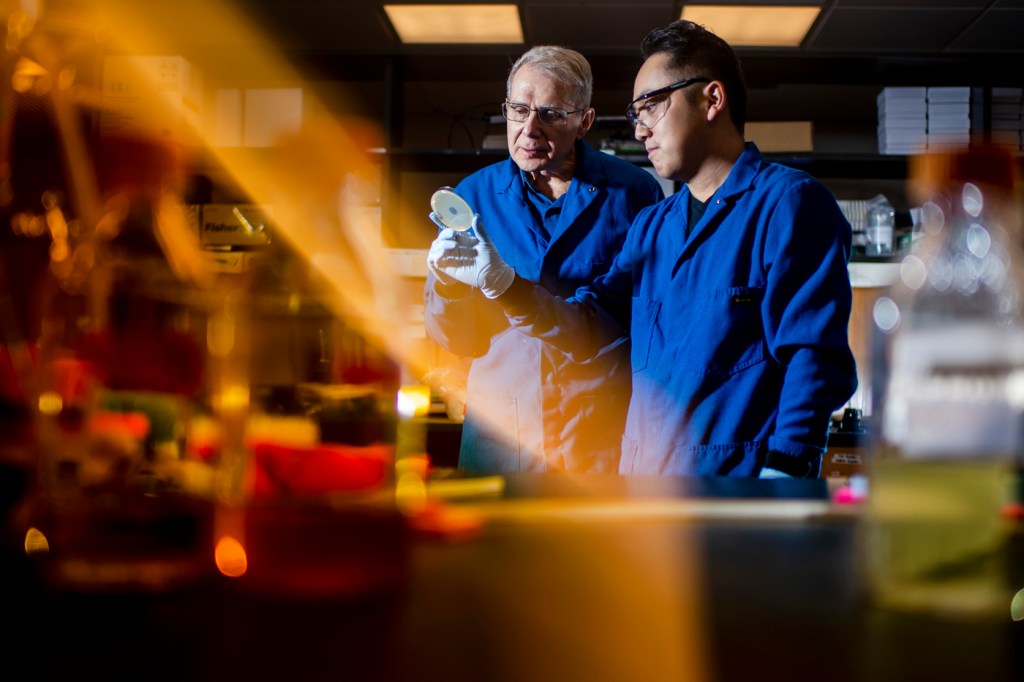New antibiotic that could treat drug-resistant infections and superbugs discovered by Northeastern microbiologist in collaboration with NovoBiotic

A new antibiotic discovered by Northeastern distinguished professor Kim Lewis could be a significant new weapon in the growing fight against drug-resistant bacterial infections and superbugs.
Lewis, a microbiologist and director of Northeastern’s Antimicrobial Discovery Center, co-authored a paper published Tuesday in the renowned journal Cell about the discovery and potential of clovibactin, a new antibiotic isolated from a previously uncultured bacterium found in the sandy soil of North Carolina.
Clovibactin blocks the formation of bacterial cell walls by an unusual mechanism. It works like a glove or cage to wrap around and bind three different phosphate-containing molecules needed to build the wall, according to researchers.
“It grows like a chain. Once the structure is built, it becomes very potent,” Lewis says. “It’s like a Velcro mechanism where each point of the Velcro is weak. But once you have the full Velcro, lots and lots of points binding to each other, you have an extremely strong binding.”
“I think this is the end of the road in the evolution towards resistance avoidance by antibiotics,” Lewis says.
The authors of the Cell article call clovibactin “a potent antibiotic” that “holds the promise of enabling the design of improved therapeutics that kill bacterial pathogens without resistance development.”
Lewis, who co-founded NovoBiotic Pharmaceuticals, one of the several research groups listed in the article, says the problem of growing antibiotic resistance needs to be addressed.
“According to the World Health Organization, we are in the midst of a pandemic of the antimicrobial resistance crisis. It’s a slow-moving pandemic, unlike COVID, but millions of people around the world die every year from multidrug resistant bacteria.”
“The pipeline is very thin for realistic leads for antibiotic development,” Lewis says, calling the discovery of clovibactin “a big step.”
“The most important thing about clovibactin, apart from its promise as a drug lead, is that it expands our understanding of antibiotics and what is possible,” he says.
99% of world’s bacteria ‘uncultured’
Only about 1% of the world’s bacteria is considered “culturable” and able to be grown in a lab and produce antibiotics.
As a result there have been no significant new antibiotics developed since the golden age kicked off by the production of penicillin in 1943 and extending into the 1960s.
A story published in 2015 detailed how Lewis and Northeastern biology professor Slava Epstein discovered a different bacterium by using diffusion chambers and other technology to “trick” it into growing in the lab.
Growing the bacterium from which clovibactin is derived required a different tack, one that Epstein, co-founder with Lewis of NovoBiotic Pharmaceuticals, sussed out.
Lewis says Epstein guessed that some bacteria in soil are in a dormant state and that, given enough incubation time, they would start propagating as rapidly as other bacteria on a petri dish.
This method was used by NovoBiotic scientists who incubated a soil sample for three months instead of the usual couple of days, and one of the cells that eventually grew belonged to a new species, E. terrae ssp. Carolina, from which clovibactin was isolated, Lewis says.
Tourist bring home trinkets; microbiologists, soil
He says It’s likely that the North Carolina soil sample was picked up by a NovoBiotic employee on their travels, or mailed in by a relative.
“The diversity of microorganisms changes with geography and soil type,” he says, which is why NovoBiotic employees bring home soil “souvenirs” from their travels.
Lewis says he participated in figuring out the mechanism of action of clovibactin with Markus Weingarth at Utrecht University in the Netherlands. Also participating in the study were researchers from the German Center for Infection Research and Bonn University in Germany.
“This is a novel type of mechanism of action,” Lewis says.
“The most exciting thing is that it is unique and binds an extremely simple target (phosphate molecules) that cannot change,” he says, adding that is why the paper is called, “An Antibiotic From an Uncultured Bacterium Binds to an Immutable Target.”
“This is the first discovery of a compound that binds a simple immutable target.”
More than a decade of research ahead
While a changeable target lends itself to resistance, Lewis says in this case the antibiotic binds to the target and then forms long fibrils on the surface of bacterial cells, building up “what we call a super molecular structure.”
So far clovibactin trials have cleared MRSA infections in mice, which Lewis calls “the gold standard to determine if your antibiotic is a realistic drug lead.”
The new antibiotic is not toxic to human cells in the lab, but Lewis says development of clovibactin as a therapeutic is a long way off.
If it proves promising at different points along the way, it could still take 12 years to come to market, he says.
“We’re at step one.”
Cynthia McCormick Hibbert is a Northeastern Global News reporter. Email her at c.hibbert@northeastern.edu or contact her on Twitter @HibbertCynthia.






